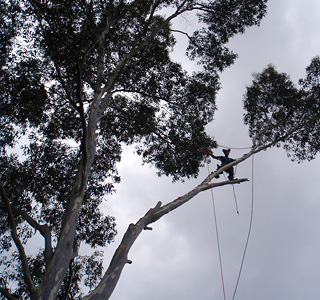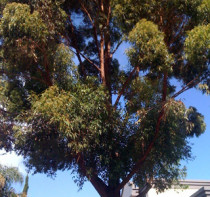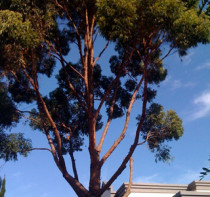What is Tree Canopy Reduction and Tree Lopping
Tree canopy reduction is often termed tree lopping in Sydney by many of those outside of the industry. Tree canopy reduction by qualified Sydney arborists is the pruning technique used to reduce the overall height or width of a canopy by reducing the apical central leaders and branches, or the end tips from larger lower limbs back to a suitable growth point. Tree canopy shaping refers to reducing particular areas of the canopy, often to create a more symmetrical overall form but can be for many reasons. The tree lopping on the Sydney North Shore carried out by our certified arborists would more correctly be termed tree canopy reduction in the professional sense.
Tree canopy reduction to reduce the height of a tree is a highly specialised form of tree pruning and needs to be performed by an experienced and professional Sydney North Shore arborists to ensure that irreversible damage is not done to the structural form and future growth of the tree. It can also only be carried out on specific species of trees and is not applicable to the majority of Australian native trees. Height reduction, what is often called tree lopping in Sydney, is so problematic that it is actually illegal according to many Sydney Council tree preservation orders and it also goes against the guidelines used in Australian pruning standards (AS4373-Pruning of Amenity Trees). The majority of Sydney North Shore Tree Lopping carried out by our arborists would involve tree canopy reduction of the side and lower branches by pruning the tips and effectively reducing the width of the canopy. This also reduces end weight in lower limbs and reduces the potential of future tree limb breakages. This Sydney tree lopping technique is a professional form of tree canopy reduction pruning and one of the most common types of tree lopping we carry out for our North Shore Sydney tree pruning clients. It is extremely important that only professionally certified Sydney arborists are used to carry out tree lopping in the Sydney North Shore since incorrect pruning cuts can cause a wide range of future safety issues with tree form and in many cases create even more problems for the owner of the property. A common example of this is the tree lopping in Sydney that is carried out where the top section of the canopy is completely removed to allow more light into a garden. The regrowth from this is then 2-3 times as dense and cuts out even more light so the client ends up with even less solar penetration. Selectively reducing and thinning of the canopy by a certified arborist that carries out Sydney North Shore Tree lopping would have allowed filtered light through the canopy on a permanent basis and prevented any costly maintenance required to keep pruning back the upper tree canopy.
What are the Tree Canopy Reduction benefits ?
Tree canopy reduction can provide a number of benefits to both the tree and the owner of the tree, these are listed below:
- Decreased end weight in large lateral limbs to reduce the potential for failure under heavy loads. Particular common technique for trees that have heavy fruits or might have a defect in the structural limb.
- Pruning back of branches to provide clearances from buildings and service wires – by far the most common type of pruning carried out for our Sydney North Shore tree pruning and Sydney North Shore tree trimming clients.
- Reduction in canopy width to create improved vistas or increased solar penetration for the clients property.
- Decreased height of tree canopy for improved vistas or solar penetration. As discussed before this cannot be carried out on most species of trees without severely impacting their form and future growth, it is most commonly done with hedging species of trees such as leylandii conifers.
- Height reduction of canopy to remove dead or decayed sections of upper canopy. This is common with old mature trees that go into regression phase whereby they lose their upper canopy branches. In this case these branches can be removed without increasing the potential for epicormic growths and the tree can remain safe and provide its amenity and environmental contribution for many more years.
How do you carry out Tree Canopy reduction ?
Tree pruning or tree trimming to reduce the height or width of the tree canopy is done according to the standards outlined in AS-4373 Pruning of Amenity Trees and also the techniques learned when obtaining a professional arborist qualification. Much of the education is based on exactly where the pruning cuts should be made with regards to the location of a branch collar to ensure that epicormic growths (i.e. new little shoots that grow very rapidly) do not appear and cause future issues with the overall tree form, and also damage is not inflicted on the section of the tree that will remain. Correct pruning exactly to the location of the branch collar will ensure the tree naturally closes off the pruning wound and its natural defence system (CODIT – Compartmentalisation of Decay in Trees) will ensure the that fungal pathogens cannot enter the main structural branches of the tree. It is also important to know what size of branches can be removed (i.e branches should always be pruned back to a branch junction no less than 1/3 of the diameter of the branch being removed) and the overall volume of branches removed from a canopy (i.e. generally no more than 10% of the canopy within one year). The skills and arborist knowledge required to carry out reduction pruning correctly is essential to ensuring the tree pruning works do not adversely effect the future form and structural integrity of the tree. Our Sydney North Shore tree pruning team only uses expert arborists to ensure you get the highest level of tree services.
What is reduction pruning ?
This is another term used to describe canopy reduction pruning which involves the reduction in length of one or several branches to decrease the overall height and / or width of a tree. It is a difficult pruning techniques to do correctly and doesn’t work with many species of trees. In many cases it is better to ensure you plant the right tree for the location in the first place rather than trying to reduce its height through pruning techniques since it will often adversely impact the natural form of the tree.
How do you reduce the size of a tree?
In some species of tree it is possible to carry out tree pruning works that can reduce the size of the tree although they all need to be done to Australian standards – AS-4373-Prunity of Amenity Tree to prevent the regrowth causing potentially hazardous and defective branches in the tree due to poorly formed attachments. The conditions outlined in AS-4373 mean that there are very few species of tree in Australia that can be pruned to reduce their overall height without effectively destroying its natural form and future structural integrity. It is for this reason that tree pruning for height reduction reasons is actually illegal in all North Shore Sydney council regulations.
Will a tree die if you cut the top off?
Tree pruning to remove the top section of the canopy, or crown, often termed “lopping” will not kill the tree but in most species of tree, particularly native species, it will cause the regrowth to create defective structural forms that can cause future safety issues from failures. Although it is possible to do some forms of tree crown reduction, it needs to be done by a very experienced arborist to ensure these future defective tree forms (i.e. epicormic growths) are not created. In many species it is simply not possible to prevent these defective forms from growing back from trees that have been ‘lopped’. For these reasons it is actually illegal in all North Shore Sydney Council areas to cut the top of all tree species with the exceptions of hedging species such as conifers. Full details of these pruning regulations can be found in AS-4373-Prunity of Amenity Trees.
Does cutting branches kill a tree?
Tree pruning and cutting of branches doesn’t not kill the tree but it should always be done by a professional arborist and in accordance with AS-4373-Prunity of Amenity Trees to ensure the tree can retain its correct structural form and health. In most cases it is not advisable to prune more than 10% from the tree canopy per annum. All Sydney Tree Solutions arborists are experts at advising our North Shore Sydney Tree Pruning clients exactly how much we pruning can occur to ensure these conditions are met.
How much does it cost to prune a tree ?
The cost of Sydney North Shore tree pruning, which is sometimes termed ‘tree trimming’ is a very common question we get from our clients and they often think there is a simple answer or that its mainly to do with how big or tall the tree is but it actually comes down to a variety of factors that in combination determine how long the works will take, what machinery is required, and the skill levels and number of personnel necessary to do the tree pruning works safely and professionally. The price to prune a tree depends on a huge variety of factors but primarily it can be determined by 3 main considerations:
– SIZE – How big is the tree – Height, Canopy width
– DIFFICULTY – Complexity of pruning process? – Complex rigging, Safety, Site factors
– ACCESS – Access from tree to road where truck and mulcher is parked.
With over 20 years of experience pricing Sydney tree pruning jobs our arborists can give you expert advice of how its best to prune a tree for its safety and also to reduce the maintenance costs that may be required. The prices get much cheaper if doing more than 1 tree on the same site.
What areas do we cover with our Sydney tree removal services ?
Sydney Tree Solutions offers tree pruning and removal services in the greater Sydney area although the majority of our customers are within the Sydney North Shore. We serve areas like Killara, St Ives, Gordon, Turramurra, Wahroonga and Hornsby in the North Shore. Other areas we provide our tree services are Castle Cove, Willoughby, Artarmon, Lane Cove, Cammeray, Mosman, Chatswood, and Castlecrag in the Lower North Shore.
- City of Sydney
Inner West Sydney
- Ashfield, Canada Bay, Leichhardt, Marrickville, Balmain, Rozelle, Annandale, Gladesville
- Henley, Hunters Hill, Huntleys Cove, Huntleys Point, Woolwich
Northern and Western Suburbs
- Beecroft, Epping, Carlingford, Cherrybrook, Dural, Glenhaven, Galston, Berowra
- Denistone, East Ryde, Eastwood, Macquarie Park, Marsfield, Meadowbank, Melrose Park, North Epping, North Ryde, Breakfast Point, Putney, Ryde, Telopea, Tennyson Point
North Shore
- Upper North Shore
- East Killara, East Lindfield, Gordon, Hornsby Shire, Killara, Lindfield
- Mount Kuring Gai, Pymble, Roseville, Roseville Chase, St Ives, South Turramurra
- Turramurra, Wahroonga, Waitara, Warrawee, West Pymble
- Lower North Shore
- Artarmon, Cammeray, Castle Cove, Castlecrag, Chatswood, Chatswood West
- Cremorne, Cremorne Point, Crows Nest, Greenwich, Kirribilli, Lane Cove
- Lane Cove West, Lavender Bay, Linley Point, Longueville, McMahons Point
- Middle Cove Milsons Point, Mosman, Naremburn, Neutral Bay, North Sydney
- Northbridge, Northwood, Riverview, St Leonards, Waverton, Willoughby
- Willoughby North, Wollstonecraft, Woolwich
Northern Beaches
- Manly
- Balgowlah, Balgowlah Heights, Clontarf, Fairlight, Manly, Seaforth
- Warringah
- Allambie, Allambie Heights, Beacon Hill, Belrose, Brookvale, Collaroy
- Collaroy Plateau, Cromer, Curl Curl, Davidson, Dee Why, Forestville
- Frenchs Forest, Freshwater, Killarney Heights, Manly Vale, Narrabeen, Narraweena
- North Balgowlah, North Curl Curl, North Manly, Oxford Falls, Queenscliff, Terrey Hills
- Pittwater
- Avalon, Bayview, Bilgola Plateau, Church Point, Clareville, Elanora
- Ingleside, Newport, North Narrabeen, Mona Vale, Palm Beach, Warriewood
- Whale Beach
Hills District
- Normanhurst, Thornleigh, Pennant Hills, West Pennant Hills, Westleigh,
- Baulkham Hills, Beaumont Hills, Bella Vista, Carlingford, Castle Hill, Seven Hills,
Forest District
- Belrose, Davidson, Duffys Forest, Frenchs Forest, Forestville, Killarney Heights
- Oxford Falls, Terrey Hills
Eastern Suburbs
- Randwick, Waverley, Woollahra
Do I need my council permission?
There are often several exempt tree pruning and tree removal works that can be done without council approvals but you may need to have council permission if the work is outside the scope of tree pruning as prescribed by the Council Tree Preservation Order. The council arborists will need to check the tree and the site to determine whether you will need permission or not. Our professional north shore Sydney arborists can also advise you on when council permits are required for Sydney tree removal and tree trimming works.
Why use Sydney Tree Solutions?
Sydney Tree Solutions is a professional tree services company that provides tree removal and tree pruning services to the north shore Sydney and greater Sydney suburbs. We have an experienced team of Sydney arborists and north shore Sydney tree removal experts to ensure that you have a safe, friendly, and professional tree removal service. Our arborists are fully certified to AQF Level 3 or AQF Level 5 and have a wide knowledge and experience on how to remove and prune all types of trees. Contact us today or call 0405 095 095 for professional tree removal and pruning services.



